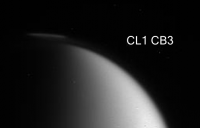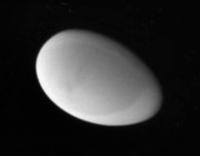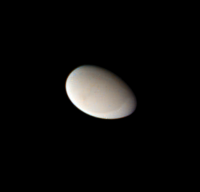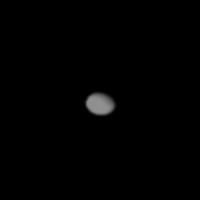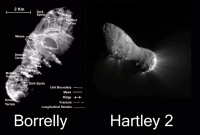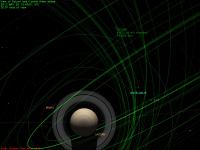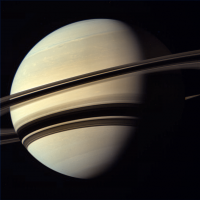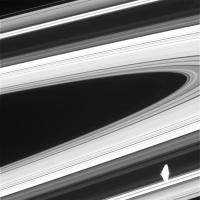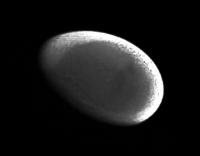Printable Version of Topic
Click here to view this topic in its original format
Unmanned Spaceflight.com _ Cassini's ongoing mission and raw images _ Rev166: May 11th - May 28th 2012
Posted by: jasedm May 11 2012, 11:48 AM
Latest http://www.ciclops.org/view/7206/Rev166 article is available.
I've been looking forward to this one for a while as we get our first decent look at Methone ![]() Closest ISS activity is from 4,500km, which should yield images comparable to the best views we have so far of Atlas.
Closest ISS activity is from 4,500km, which should yield images comparable to the best views we have so far of Atlas.
There are also images planned of Tethys' trailing hemisphere from mid-ranges, and of course a close (955km) Titan flyby with specular-reflection searches, and radar swaths at C/A. This is the flyby whereby Titan bends Cassini's orbit 'down' and out of the ring plane for the next couple of years.
I know we can't have it all, but I was hoping for another decent look at Telesto on this rev (Cassini buzzes past at around 11,000km) which would have given us images at high phases and from almost the same range as the flyby in 2005. Never mind, there's another similar-range pass to Telesto in 2015.
Lots to look forward to.
Jase
Posted by: Holder of the Two Leashes May 11 2012, 02:50 PM
At last.
Posted by: jasedm May 11 2012, 08:22 PM
Re: Methone, Emily's wish came true....(from 6 years ago on this forum):
"Although I wouldn't call this a "main focus," I would like to see the trajectory studied hard for the opportunity to do a pretty close flyby (say around 2,000 km) of one of the itty bitty moons, and to give the flyby a resonably dense set of observations. The closest Cassini will get to any of those things during the primary mission is 10,000 km from Telesto, which happened on October 11. Hyperion looked so bizarre up close, I'd like to see what one or two of the itty bitty ones -- Methone, Pallene, Calypso, Polydeuces, or Helene looks like from that kind of perspective."
--Emily
![]()
Posted by: machi May 11 2012, 10:47 PM
Does anyone know why is imaging from 4,500 km and not from ~2,000 km (closest distance to Methone)?
Posted by: nprev May 12 2012, 12:50 AM
I'm guessing that the relative motion at closest approach might be too high for a target with such a small angular diameter.
Posted by: Phil Stooke May 12 2012, 01:12 AM
Or maybe the closest view direction would be very high phase angle? (mostly shadow)
Phil
Posted by: machi May 12 2012, 04:39 AM
According to great PS site http://www.planetary.org/explore/space-topics/space-missions/cassinis-tour.html ,
Methone flyby is at modest speed 5.1 km/s, but relatively high phase angle 126°, so I think, that Phil can be right.
But on other side, even high phase angle images are very useful, not only because Methone will be much closer in this case (1861 km), but because of photometric investigations of Methone's surface (regolit roughness etc).
Posted by: jasedm May 12 2012, 07:46 AM
My guess is that there is perhaps still sufficient uncertainty about perturbations to Methone's orbit, that the further distance ensures Methone falls within frame. (remember the Helene flyby where some the closest NAC frames missed Helene altogether)
Jase
Posted by: ugordan May 18 2012, 04:09 PM
Titan's south polar haze layer is certainly starting to look interesting. Judging by these http://saturn.jpl.nasa.gov/photos/raw/rawimagedetails/index.cfm?imageID=261529 and http://saturn.jpl.nasa.gov/photos/raw/rawimagedetails/index.cfm?imageID=261532 images, it would appear larger particles (judging by the prominent visibility in the infrared CB2 filter as well) are piling on top of the detched haze layer (!?).
Posted by: titanicrivers May 20 2012, 06:08 PM
Interesting indeed. A bright portion is visible even in the CL1 CB3 images. Using the filters' depth penetration one can build a nice visual analysis of the S Polar haze from Cassini's most recent Rev 166 images.
Posted by: belleraphon1 May 21 2012, 02:29 PM
Methone and Tethys images are here:
Methone - wow!? Smmooth....
http://saturn.jpl.nasa.gov/multimedia/images/raw/casJPGFullS73/N00189072.jpg
Tethys
http://saturn.jpl.nasa.gov/photos/raw/rawimagedetails/index.cfm?imageID=261595
Craig
Posted by: Bjorn Jonsson May 21 2012, 03:09 PM
Wow. At this resolution Methone seems completely free of craters. Coated with a thick layer of dust or could this small body simply be a 'clump' of dust?
Posted by: belleraphon1 May 21 2012, 03:21 PM
Probably getting coated by a lot of ice particles from Enceladian plumes? Cool little worldlet.
Posted by: Phil Stooke May 21 2012, 03:26 PM
Spectacular! Here's a cleaned-up and contract-enhanced image of Methone. There are real albedo variations across it.
Phil
Posted by: machi May 21 2012, 04:59 PM
Wow! This must be the biggest egg in the Universe! ![]()
Posted by: jasedm May 21 2012, 06:40 PM
Methone is very reminiscent of Pallene - peanut-shaped and very smooth. Interesting.
Posted by: ngunn May 21 2012, 10:03 PM
That's interesting. The smooth shape says it's a snowdrift with a young surface, but the albedo differences can't be accounted for that way. How would the lighter and darker patches perpetuate themselves? Maybe there's a postive feedback loop (like Iapetus) that is sufficiently vigorous to keep up with the 'snowfall'.
Posted by: jgoldader May 21 2012, 10:19 PM
I hope the Angry Birds Space people are paying attention....
Jeff
Posted by: Xerxes May 22 2012, 04:21 AM
Submitted for your derision: my first attempt at processing Cassini data, an approach movie for Methone. The noise algorithm clearly needs some work...
Posted by: tasp May 22 2012, 04:34 AM
Would the presumed particles coating the surface (if it isn't that way all the way through) be charged and discharged by Saturn's magnetic field and 'sorted' somehow by size (or something) and that is making the albedo variations? Or maybe the particles are not spherical, and their orientation is aligned that way and that makes them look different in different regions.
Posted by: elakdawalla May 22 2012, 04:35 AM
Good job. I tried something similar, painting out the cosmic ray hits, but there were so many that I realized I wasn't so much painting things out as I was painting a picture of Methone, so I quit. I think it probably is better to leave them in, for now. Once we can get our hands on data that's not been JPEG-compressed, it'll be substantially easier to remove them.
Posted by: Holder of the Two Leashes May 22 2012, 05:19 AM
Very pleased indeed that they got these good shots of Methone.
Albedo variations?!?
As usual, I had no idea what to expect. But whatever it was that I was not expecting, this wasn't it.
Posted by: elakdawalla May 22 2012, 05:33 AM
Posted by: Paolo May 22 2012, 06:18 AM
I get the feeling that Methone is not unlike Atlas: it probably has a solid core and a smooth cover of ring dust, as dense as freshly fallen snow, filling its minuscule Roche "sphere of gravitational influence". don't forget that Methone has its own ringlet from which to collect dust. too bad we don't have a reliable estimate for its mass, otherwise it would be easy to compute the size of its sphere of influence. I bet it's of the order of 6 km across...
Posted by: titanicrivers May 24 2012, 01:42 AM
Fascinating object. Cometary size and incredible smoothness like some parts of comets visited by spacecraft in the last decade (see below). Could methone be a captured comet, its passage around the sun vaporizing the volatiles on/in its surface, smoothing its crust and perhaps passing too close to Saturn (in or outbound) and thus captured in its altered state???
Posted by: stevesliva May 24 2012, 02:18 AM
Lots of the other tiny moons might fit that description, and they're all basically pieces of the ring system, so it's unlikely they're a comet. The 2010 photos of Calypso are striking. Atlas, too.
Posted by: Explorer1 May 24 2012, 02:19 AM
What hemisphere are we looking at here, trailing or leading (or a combination of both)?
Posted by: Paolo May 24 2012, 07:31 AM
beside, a captured comet would likely end in a distant, irregular orbit. Methone is in a stable, almost circular orbit deep into the Saturnian system. and an object jumping from the former to the latter would be far more likely to crash on a large moon like Titan, Iapetus or Rhea than to reach the final orbit.
Posted by: jasedm May 24 2012, 05:31 PM
In passing, a milestone of distance travelled for Cassini on this last revolution - see attached...
Posted by: ugordan May 24 2012, 06:11 PM
I never cared much for the "total distance travelled" number. Isn't it really pretty meaningless when you think about it? What frame of reference was used? Cassini was cruising through the solar system for 7 years so one can assume the trajectory length centered around the Sun was what was measured. What happened when it entered the Saturnian system, did the statistic switch (and at which point?) to measuring the length of all the ellipses centered around the Saturn or still the heliocentric path?
It's also much easier to clock in billions of km if you're in the inner solar system. Speaking of which, how "far" did MESSENGER travel?
Posted by: john_s May 24 2012, 08:06 PM
And how far have I travelled, sitting on my butt reading UMSF ? ![]()
John,
Posted by: jasedm May 24 2012, 08:53 PM
Uh ok... sorry.
Posted by: ugordan May 25 2012, 04:31 PM
No need to apologize. To each his own.
Posted by: Greenish May 25 2012, 05:46 PM
What is the orientation of Methone? Is the long axis pointed towards Saturn (similar to a gravity-gradient stabilized spacecraft)? If this is in fact a loose dust pile, is this the expected type of deformation?
Posted by: jasedm May 25 2012, 06:03 PM
Indeed.
Thank you for your forbearance. In future I shall ensure I assiduously check the frames of reference employed, before posting such thoughtless frippery.
Posted by: ngunn May 25 2012, 09:26 PM
I like replying to a first post because it gives me the chance to say: Helllo and welcome.
I don't know the answer to your question, but it's a good question! My first guess is that material is deposited preferentially around the equator as is the case with Atlas so no reorientation is needed for that, in fact it's self-stabilising. That establishes an oblate ellipsoid with one short axis and two long ones. I'm not sure that the recent images imply a significant difference between the two axes in the equatorial plane, so it may not have 'a' long axis.
Posted by: volcanopele May 25 2012, 10:12 PM
North is down in the raw images.
Posted by: Greenish May 26 2012, 04:04 AM
I don't know the answer to your question, but it's a good question! My first guess is that material is deposited preferentially around the equator as is the case with Atlas so no reorientation is needed for that, in fact it's self-stabilising. That establishes an oblate ellipsoid with one short axis and two long ones. I'm not sure that the recent images imply a significant difference between the two axes in the equatorial plane, so it may not have 'a' long axis.
Heh... I've been lurking a while, didn't realize it was actually my first. Thanks for the welcome. I've learned a lot here!
So Methone is shaped more like a Skittle than a football? That wasn't clear (to my uncalibrated eye) from the images, or comparisons others made to elongated asteroids, and I hadn't seen any actual 3-axis numbers, just a mean radius estimate. But it guess it would be a more expected shape for something that formed there versus being captured. I guess we'll see.
Posted by: rlorenz May 26 2012, 01:10 PM
Hmm. I suggest with an international audience skittle and football are poor words to use as shape descriptors.....
Skittle, upper case, as in the (US) candy means oblate spheroid (one short radius, two long) and could be referred to by the UK sweet named a Smartie (like US M&M ; I'm a big fan of food analogies in planetary science, by the way...)
but a skittle (lower case, UK useage) could refer to a bowling pin - a perhaps bi-lobed prolate spheroid (two short radii, one long)
rather like comet Borelly. So without catching the case of the leading character, it's a bit ambiguous.
And then there is football, which to much of the world means a sphere (or a convex-hulled truncated icosahedron leather approximation of the same) rather than the prolate ellipsoid which you actually mean in US useage..... ;-)
Maybe someone can make a cool montage of confectionery and sports goods, with the aspect ratios and end radii marked up - maybe there are even some 'universal' confections like (originally Italian) Tic-Tac's that are good analogs of planetary bodies...
Posted by: rlorenz May 26 2012, 01:12 PM
I can't believe I just mis-spelled usage, twice.
Posted by: Explorer1 May 26 2012, 05:03 PM
I think we would have noticed if Methone was as irregular as a bowling pin (like that dog-bone asteroid, Kleopatra?)
Or we can go with eggs, those are universal, right? ![]()
Posted by: Stu May 26 2012, 05:30 PM
Actually, when you said Skittle' this UK resident thought you were referring to the small, coloured-shell chewy sweet ('candy' in US usage...) ![]()
Posted by: john_s May 26 2012, 07:32 PM
We've been used to having north "Up" in the images, but now that the sun is north of the ring plane, post-equinox, it's easier to keep the spacecraft radiators in the shade (as they need to be) by flying "upside down". So north "down" will be more common for the rest of the mission.
John
Posted by: Greenish May 26 2012, 10:50 PM
Probably not the best descriptors, the geometrical ones are better... compared to other forums this is not a lay audience nor a US-centric one.
To the point though, and not trying to be repetitive - I'd be interested if anyone can tell if it is prolate or oblate.
Posted by: nprev May 26 2012, 11:48 PM
Well, you got "icosahedron" right, so I'd say you're still on the plus side, Ralph...
Posted by: ElkGroveDan May 27 2012, 02:05 AM
That's OK. You got "bi-lobed prolate spheroid" so we can let it pass.
Posted by: ngunn May 27 2012, 07:13 AM
Me too!
Posted by: Ian R May 29 2012, 11:25 AM
One of the last datasets from this Rev: a wide-angle view of Saturn, rendered in CB2 / Synthetic Green / Blue:
Posted by: Phil Stooke May 29 2012, 01:43 PM
"I'd be interested if anyone can tell if it is prolate or oblate."
I'm fairly sure it is prolate, elongated on one of its equatorial axes. But we will need more views to get a good shape model.
Phil
Posted by: jasedm Jun 1 2012, 01:02 PM
Is that Mimas?
Taken on 23rd May from around a million km from Saturn.
If my surname began with Hoag- and ended with -land I would be beside myself. ![]()
Edit: it is Mimas - that's Herschel to the left.
Posted by: jasedm Jun 1 2012, 05:59 PM
A little play-around with the best Methone image - processed to within an inch of its life. Is that a tantalising hint of detail in the darker area, or am I enhancing artifacts?
Posted by: JohnVV Jun 3 2012, 08:27 AM
--edit---
Posted by: Phil Stooke Jun 3 2012, 02:22 PM
There is real detail in the darker area, in the form of slightly darker smudges. Real because it shows up in all the images, not just one. I don't see any obvious topographic expression of it, but the sun is nearly overhead at that location.
Phil
Powered by Invision Power Board (http://www.invisionboard.com)
© Invision Power Services (http://www.invisionpower.com)

